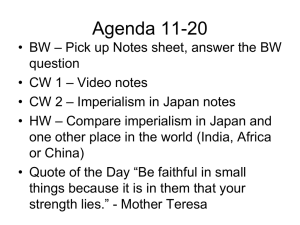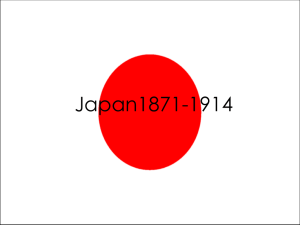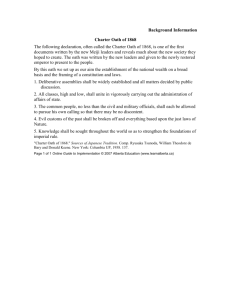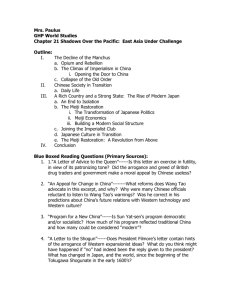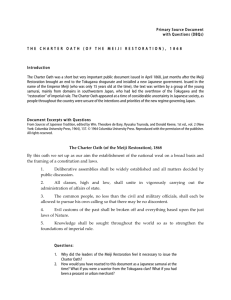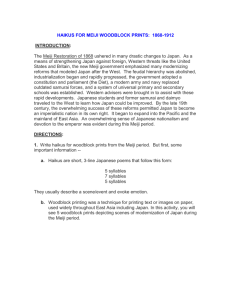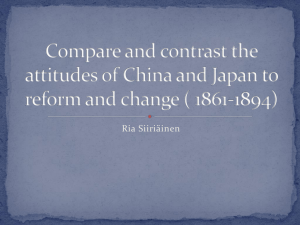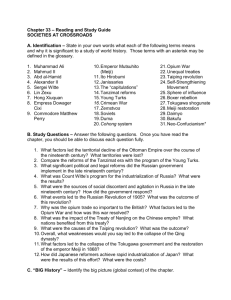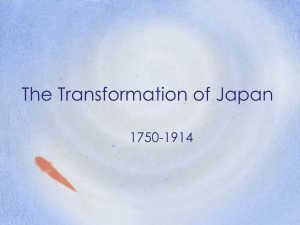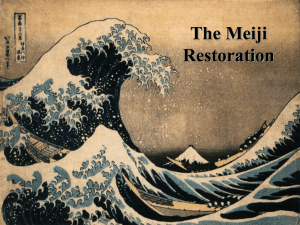Charter Oath and Meiji Reform
advertisement
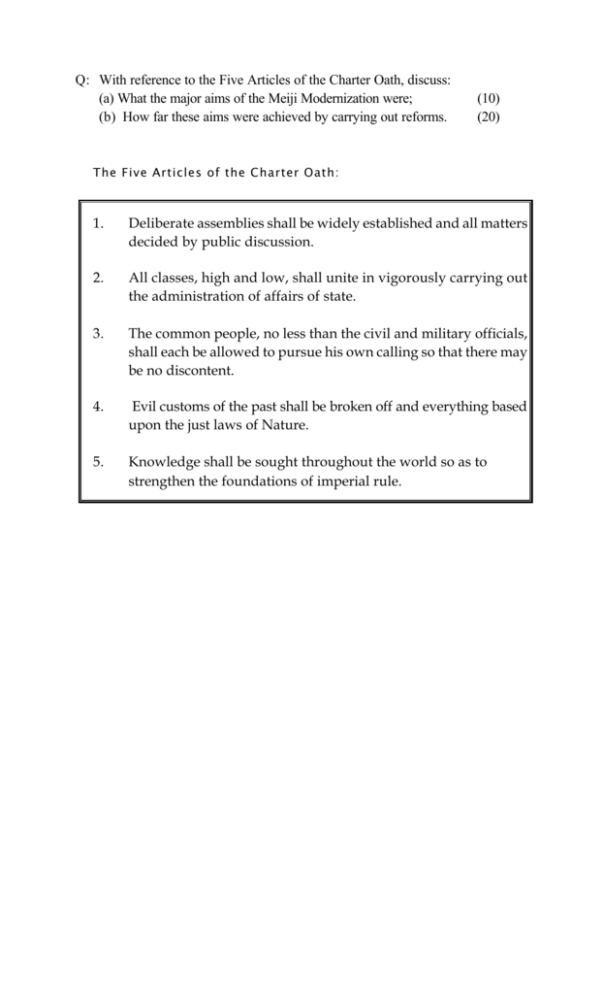
Q: With reference to the Five Articles of the Charter Oath, discuss: (a) What the major aims of the Meiji Modernization were; (b) How far these aims were achieved by carrying out reforms. (10) (20) The Five Articles of the Charter Oath: 1. Deliberate assemblies shall be widely established and all matters decided by public discussion. 2. All classes, high and low, shall unite in vigorously carrying out the administration of affairs of state. 3. The common people, no less than the civil and military officials, shall each be allowed to pursue his own calling so that there may be no discontent. 4. Evil customs of the past shall be broken off and everything based upon the just laws of Nature. 5. Knowledge shall be sought throughout the world so as to strengthen the foundations of imperial rule. Introduction: When we study the modern history of Japan, we are always amazed by Japan’s achievements in the Meiji Modernization. It is because Japan had become a modernized country with prosperous economy and strong military after a rapid modernization. Japan was then able to win equality with the West and attain a world power status. The changes took place within half a century. Why was Japan able to modernize the country so rapidly? What were the key elements of her success? Many reasons contributed to the success of the Meiji Modernization. One important reason was that the Meiji government had set some targets for the modernization in the Charter Oath. The Five Articles of the Charter Oath provided appropriate aims and guidelines for the Meiji Modernization. These aims could respond to the needs of the country and the people of the time. Besides, these aims were greatly achieved by carrying out reforms. So it is significant to go over the Five Articles of the Charter Oath, to analyse the aims of the Meiji Modernization from the articles, and to discuss how these aims were achieved in the reforms. It explained for the success of the Meiji Modernization. On the other hand, we should also discuss the limitations of the Meiji reforms of achieving these aims. Although the Charter Oath proclaimed some aims of the Meiji Modernization, it could not fully reflect the targets and intentions of the Meiji government. For example, some tradition beliefs were emphasized in the reforms, such as loyalty and absolute obedience. These intentions or targets were not shown in the Charter Oath, but greatly influenced the development of Japan. From analyzing the limitations of achieving the aims proclaimed in the Charter Oath, we can realize these hidden intentions of the Meiji government and understand the nature of the Meiji Modernization. The essay will focus on the relations between the Charter Oath and the Meiji Modernization. The Charter Oath was known as the guidelines of the Meiji Modernization. However, the question of how the Five Articles of the Charter Oath guided the Meiji Modernization was seldom discussed. In fact, the information about the Charter Oath provided in the history text books was inadequate. The essay consists of two parts. Part (a) requires students to discuss the aims of the Meiji Modernization with reference to the Charter Oath. Firstly, students should review the Five Articles of the Charter Oath. Secondly, they should analyse and conclude the major aims of the Meiji Modernization from the Charter Oath. In this process, some students might have difficulties in coming up with the answers. They are advised to study the background of the Meiji Modernization first. Students can understand the aims of the modernization easily by studying the problems of the old systems of the Tokugawa Shogunate. In this project, exercise 1 was designed to help students to understand the problems of the old system of Japan. Exercise 2 helps students to think about the major aims of the Meiji Modernization from the Charter Oath. Part (b) requires students to analyse how far the aims were achieved by carrying out reforms. Students should discuss both the effectiveness and limitations of the reforms of achieving the aims. Besides, they should also evaluate how far the aims were achieved with relevant material. In the project, exercise 3 was designed to help students to answer Part (b). This project was mainly divided into three sections. Section I consists of the three fill- in-the blank exercises. Section II consists of two sets of worksheets to guide students to write the essay. A marking-criteria table is included in this section. Students were asked to write the essay for two times. Section III discusses students’ performance of the essays. A sample essay is also provided in this section. 2 Section I: Worksheets Exercise 1: Challenges to the old systems Before the Meiji Restoration of 1868, the Shogunate had ruled Japan for over 600 years. Many old systems of the Shogunate could not respond to the new challenges in the 19th century. Let’s revise what the old systems of Japan were and discuss how these systems failed to respond to challenges. The systems of the Shogunate Political Systems: Problems in responding to challenges Challenges: The feudal system The coming of the West in the mid-19th century. Description: Problems: Japan’s real ruler was the Under the military threat of the foreign countries, ___1___ and the figurehead was Japan was forced to open the door and was forced to the ___2___. sign unequal treaties in the mid-19th century. Under the feudal system, Japan Since the Shogunate could not resist ___7___, its was divided into more than 200 weakness was exposed. Finally, the Shogunate was political units called ___3___. overthrown and the ___8___ restored his power in Each of these political units was 1868. It was called the Meiji Restoration. governed by a feudal lord called ___4____. In order to maintain The new government was mainly formed by a group his political and economic of young ___9___. They came from the Western powers in his land, he could clans. The government was called the ___10___. ___5 ___and ___6___. But the feudal system still remained. So the government’s power was limited and not strong enough to resist the foreigners. Social Systems: Class Division System Description: Challenges: Decline of the samurai & Development of money economy. Problems: There was a strict social division But more and more people were discontented with in the Japanese society. People this social system. were divided into 4 classes, they The ___19___ were professional warrior, but they were ___11___, ___12___, gradually lost their function in a stable environment. ___13___ and ___14___. Most of them lived ___20___ and were indebted. Only the ___15____ was the The lowest class of the society was the ___21___. ruling classes who enjoyed lots But they became richer because of the development of privileges, such as the right to of the ___22___ economy, but their social status was wear ___16___, receive still low. ____17_____ training. The ___18____ was the lowest class. So many people were discontented with the class division system. People must live in accordance with the regulations and practices of own classes. 3 Foreign System: Relation The Sakoku (isolation) policy Description: Challenges: Many powers were interested in Japan. They tried to open Japan’s door in the mid-19th century. Under the military threat, Japan signed the Treaty of Kanagawa with the America in 1854. Since then, other powers also signed treaties with Japan. Problems: In 1622, missionaries were not The powers forced Japan to open treaty ports and allowed to spread ___23___ in gained some special interests in Japan, such as Japan. _____24_____, _____25______ and _____26______. Since 1640, the Shogun decided to close the door of Japan. The Opening of Japan exposed the weakness of the No trade was allowed with ____27____ since he could not expel the foreigners foreigners. and was even forced to sign unequal treaties. Japanese were forbidden to go The Sonno-Joi Movement started. Finally, the abroad. 15-year-old Emperor Meiji restored in1868. This event was called the___28___. To avoid a foreign war, the new government had to revise the foreign policy Choices for Exercise 1 (Each answers can be used more than once) 1 5 9 13 17 chonin samurai Meiji Oligarchy extraterritoriality education & military 2 6 10 14 18 domains peasants Meiji Restoration conventional tariffs most-favoured-nati on status 3 7 11 15 19 daimyo artisan Christianity luxuriously keeping fighting forces 4 8 12 16 20 Answers of Exercise 1 1 2 3 4 5 6 7 8 9 10 11 12 13 14 15 16 17 18 19 20 21 22 23 24 25 26 27 28 4 emperor swords money foreign aggression collecting taxes Exercise 2: The Charter Oath – Solution to the problems of Japan You have already discussed the problems of Japan’s old systems. When the Meiji government came to power in 1868, it decided to carry out the Meiji Modernization to strengthen the country and solve these problems. Firstly, the emperor proclaimed the Charter Oath as the guidelines of the modernization. Revise the Five Articles of the Charter Oath, discuss the major aims of them. What problems did the articles try to solve? Problems Political: The Five Articles of the Charter Oath Related Article(s): The feudal system & Political Article (__3__) : Instability ____________________________________________________ Although the emperor ________________________________________________ restored his power, his power was limited. He only ruled over Tokyo and the lands confiscated from the Aims & Suggestions: Tokugawa. It was because the ___1____ system still existed and the The new government tried to gain support from the public, ___2___ remain control over especially the daimyo. Then, the government could consolidate its power. their domains. It was an unfavourable To achieve this aim, it promised to set up ____4____ and respect situation for Japan. A weak ____5___. government could not lead Japan against foreign aggression. Social: Related Article(s): The Class Division System & Article ( ___6____) Social Discontent ____________________________________________________ ________________________________________________ Many people were discontented with the class division system. The system Article ( ____7____) restricted their freedom and ____________________________________________________ they looked for changes. ________________________________________________ Aims & Suggestions: The government tried to unite all people to strengthen the country. To achieve this aim, the ___8____system would be abolished. Every people would be allowed to pursue his own ____9____ and have the freedom to choose his work and live. 5 Foreign Relation: Foreign Aggression Modernization Related Article(s): & Article ( ___11____) ____________________________________________ Japan was under foreign ____________________________________________ aggression. To avoid a foreign war, Japan must not break the relation with the Article ( ___12____) West. ____________________________________________________ On the other hand, the ____________________________________________________ government had to carry out the ___10___ in order to strengthen the country and resist foreign aggression. Aims & Suggestions In order to strengthen the country, the government believed that Japan should carry out reforms and learn from the outside world. To modernize the country, domestic reforms should be carried out and the past evil ____13_____ should be abolished. Western culture should be introduced to Japan. Then, Japan would be a Western style modern nation. It might help Japan to improve the relation and win ___14____ with the West. Finally, Japan would be able to revise the ____15____treaties and regain her sovereignty. Choices for Exercise 2 (Each answer can be used more than once) 1 assemblies 2 equality 3 class division 4 daimyo 5 feudal 6 public 7 unequal 8 Meiji discussions 9 customs 10 Modernization calling Answers of Table 2 1 2 3 4 5 6 7 8 9 10 11 12 13 14 15 6 Exercise 3: Achievement and Limitation on fulfilling the aims After the proclamation of the Charter Oath, the Meiji government started to reform the old systems and modernize the country. How were the aims mentioned in the Charter Oath achieved in the reforms? What were the limitations on achieving the aims? Aims How the aims were achieved in reforms Limitation on achieving the aims Remarks Setting up The Emperor Meiji restored to power in 1868. However, his power was limited. He The government had adopted the system of In the Charter Oath, the had to solve the problem of consolidating his control over the country. Before 1871, he Constitutional Monarchy in Japan since 1899. government promised to assembles maintained the ____1___ system, so the daimyo could retain traditional autonomy over Although it was a modern political system, it did set up assemblies and their domains. not bring real ____13____ to Japan. encouraged public and discussion. encouraging The new government, which was named the ____2____, was mainly formed by the The constitution was granted to the Japanese samurai of the ___3___ clans. In order to gain support from other daimyo, the people by the emperor as a favor. The supreme Could this aim really be public government formed a bicameral national assembly (Kogisho) – the upper house made power remained in the hands of the ___14___, for achieved in the Meiji discussion up of court nobles and daimyo; the lower house made up of representatives from each example, he could ___15___ the Diet and amend reforms? How far could domain. the ___16___. the aim be achieved? Later, more and more people were discontented with the rule of the Meiji Oligarchy. Moreover, the power of the ___17___ was Did the Meiji Finally, Japan adopted the Constitutional Monarchy after the proclamation of limited, it could approve laws only, but it was not government set up ____4____ in1889. a law-making body. assemblies and The ___5___ was set up which consists of two houses – the House of Peers & the encourage public House of Representatives. Besides, few people had the right to vo te. Only discussions? Members of the House of Peers were appointed by the emperor. The Japanese people ___18___ adults who paid annual ___19___ of 15 could become elected members of the House of ___6___ through ___7___. yen or above could vote for the House of Function of the Ho use of Representatives included approving ___ 8____ and refusing Representative. (About only 1 % of the Were the Japanese the _____9_____ of the government. population were entitled to vote in 1890.) satisfied with the reforms? The Constitution also granted the Japanese people certain human rights, such as the freedom of ____10____, ____11____ and ____12____. Could the reforms help the government win popular support? Abolishing the The Meiji government decided to abolish the Class Division System to get rid of social The Meiji government was mainly set up by some The government tried to discontent. Then, all people would be united to promote national welfare. former ___29___ of the western clans, so the unite all people and let Class former ruling class still controlled the country. them pursue own calling so as to promote national 7 Division In 1871, the ___20___ system was abolished. Then, daimyo and samurai, the ruling so as to promote national class of the society, lost their privileges. Social reform had also brought about discontent welfare and gain popular System and The ___21___returned their land and people to the emperor. The country was towards the government. The ___30___ felt support. re-organized into 72 prefectures. frustrated with the changes since they lost their allowing The samurai lost their function as warriors. The government ordered the ___22___ to traditional status and privileges. people to disband in 1871. So the samurai lost their traditional occupations and were allowed to The discontented samurai staged ___31___. The Did the reforms taken by the government achieve most serious one was the Satsuma revolt of 1877. the aim? pursue own take up new occupations. In addition, they lost their privileges. In 1873, the government declared the ___23____ calling to establish a conscripted army. In 1876, they were prohibited from wearing Some peasants also revolted because they were Did any class feel ___24____ that was a traditional symbol of their privilege. discontented with the fixed land ___32___ and satisfied about the compulsory ___33___. reforms? Why? The government guaranteed the daimyo a fixed income and took over their debts as compensation. Some daimyo invested the money on commerce or industry. Furthermore, the industry of Japan was controlled Although the samurai lost their annual___25___, they could gain a lump sum payment by ___34___, which were powerful industrial and Did any people oppose instead and their ____26___ were taken over by the government. Some ex-samurai financial combines. the reforms? How did invested the payment on commerce or industry. Some of them joined the labour force. They were able to dominate the economy of they react to the Japan. With close relation with the Meiji leaders, government? The government asked all classes to contribute the country. New opportunities were they could also affect the economic policy of provided to all people. Japan. Commoners could assume family names in 1870. People could choose their occupations and lives. According to the Education Act of 1872, all children could receive __27__. The ___28___ was declared in 1873. All men should join the military service for 3 years. Abolishing In order to modernize and strengthen the country, the Meiji government decided to Although Western culture and knowledge were The government tried to learn from the world and break off the evil customs of the past. introduced to Japan, traditional culture was learn from the world and the evil emphazised by the government. The government abolish evil customs so Education reforms were carried out. Students were sent abroad and foreign teachers did not aim at changing the traditional belief of as to modernize the customs of were employed to teach in Japanese schools. Foreign languages were taught. Western the country. country and win equality the past and books were translated into Japanese. with the West. 8 the past and Some intellectua l began to challenge the traditional value, such as absolutely obedience Fearing that the young generation might be and loyalty. They were interested in some Western ideas, such as ____35_____, influenced by the Western ideas, such as Do you think Japan was seeking _____36_____ and materialism. liberalism and individualism, the government a modernized country after introducing the knowledge The reforms raised the ____37____ of Japan and provided skilled ___38___ for the issued the _______51______ in 1890. country’s development. It emphasized the importance of ____52____ and reforms? Explain your throughout absolutely ____53____ to the emperor and the answer. To strengthen the national defense, Japan’s army was reformed on ___39____ model country. the world and her navy was reformed on ____40____ model. Western weapons and warships Could Japan win were imported. After learning western military technology, Japan produced her own The spirit of ____54____ (the spirit of warrior) equality with the West? weapons and warships. was upheld in the army and navy. Give examples. The military reform enabled Japan to gain victories in foreign wars. For instance, she defeated ___41___ in the Sino-Japanese War of 1894. She defeated ___42___ in the Moreover, religion was made a tool to Was Japan a fully Russo-Japanese War of 1904. indoctrinate the people with nationalistic ideas. Westernized country? ____55____ was chosen as the state religion to Did the Japanese reserve Economic reforms were introduced. The government invited foreign financial experts strengthen the divine status of the ____56_____. their own culture? to Japan. Industry was developed. Foreign technology and material were applied in building railways. The Japanese family relationship, which Japan successfully developed into a modern ____43____ country from a backward emphasized the important position of the agricultural country. headman, remained unaffected. The Japanese still wore their national costumes Legal reforms were introduced. A criminal code was adopted on the French model; a on most occasions. ___44_____ code was adopted on the German model; a commercial code was passed People’s way of speaking often showed their on the German model. social status. Some evil judicial practices, such as ___45___, were abolished. The reforms modernized Japan’s legal system, Britain finally agreed to give up her ____46____ in Japan in 1899. Other countries followed her examples. Moreover, Japan regained her ____47____ autonomy in 1911. Western culture was introduced to Japan. Western ____48____ became fashion. Western hairstyle became popular. Some wealthy people built their houses in Western style. Western ballroom dances were held on social occasions. The attempts on Westernization transformed Japan into a ____49____ style modern nation. It helped Japan to win ____50____ with the West and raised her international status. 9 Choices for table 3 (Each answer can be used more than once) 1. 1 emperor 2 Diet 10 Representatives 11 budgetary proposals 2. 1 daimyo 3. 1 emperor 10 China 19 obedience 2 swords 2 11 20 3 12 3 income male dissolve 4 4 13 revolts 5 tax Buishido 3 loyalty Russia 12 literacy Imperial Prescript 21 clothing on Education 4 13 22 tax democracy 5 14 6 Zaibatsu 7 laws speech debts 8 Western 5 tariff labours 14 civil extraterritoriality 6 15 Meiji religion education 9 6 15 7 16 feudal publication 8 17 election western 9 constitution feudal 10 samurai 11 Conscription Law 12 military service individualism torture 7 16 liberalism industrial 8 17 German equality 9 18 British Shintoism Answers of Table 3 1 2 3 4 5 6 7 8 9 10 11 12 13 14 15 16 17 18 19 20 21 22 23 24 25 26 27 28 29 30 31 32 33 34 35 36 37 38 39 40 41 42 43 44 45 46 47 48 49 50 51 52 53 54 55 56 10 Section II: Essay Outline & Marking Criteria A1: Writing an outline for the essay (for the first edition of the essay) With the help of Exercises 1, 2 and 3, write an outline for the essay. Q: With reference to the Five Articles of the Charter Oath, discuss: (a) What the major aims of the Meiji Modernization were; (10) (b) How far these aims were achieved by carrying out reforms. (20) 1) Introduction: a) Define the terms -- the Meiji Modernization; the Charter Oath b) Describe the background of the Meiji Modernization in brief c) State the approach – First, discuss the major aims of the Meiji Modernization in accordance with the Charter Oath. Second, discuss the achievement and the limitation on achieving these aims. 2) Content: a) What is the Charter Oath? b) What is the nature of the Meiji Modernization? c) With reference to the Charter Oath, indicate the major aims of the Meiji Modernization in brief. i) Article 1-- _______________________________________________________________ ii) Article 2 & 3 -- ___________________________________________________________ iii) Article 4 & 5 -- ___________________________________________________________ d) How far was the aim of Article 1 achieved by carrying out reforms? i) Achievement -- __________________________________________________________ ii) Limitation -- ____________________________________________________________ Conclusion -- ____________________________________________________________ ________________________________________________________________________ e) How far was the aim of Article 2 & 3 achieved by carrying out reforms? i) Achievement -- __________________________________________________________ ii) Limitation -- _____________________________________________________________ iii) Conclusion --______________________________________________________________ ________________________________________________________________________ f) How far was the aim of Article 4 & 5 achieved by carrying out reforms? i) Achievement --________________________________________________________ ii) Limitation -- __________________________________________________________ iii) Conclusion --__________________________________________________________ ____________________________________________________________________ 3) Conclusion: a) Respond to the whole essay 11 b) You may mention the significance of the Charter Oath & the Meiji Modernization. 12 A1: Writing an outline for the essay(for the first edition of the essay ---- for teachers’ reference) Q: With reference to the Five Articles of the Charter Oath, discuss: (a) What the major aims of the Meiji Modernization were; (b) How far these aims were achieved by carrying out reforms. (10) (20) 1) Introduction: a) Define the terms -- the Meiji Modernization; the Charter Oath b) Describe the background of the Meiji Modernization in brief c) State the approach – First, discuss the major aims of the Meiji Modernization that proclaimed in the Charter Oath. Second, discuss how far these aims were achieved in the modernization.. 2) Content: a) What is the Charter Oath? The Charter Oath is the guidelines of the Meiji Modernization. b) What is the nature of the Meiji Modernization? It is a modernization movement to modernize and strengthen the country. c) What were the major aims indicated in the Charter Oath? i) Article 1 – the government tried to gain support by promising setting up assemblies and encouraging public discussion. ii) Article 2 & 3 – the government declared to abolish the class system to unite all people. It would help the government get rid of social discontent and promote national welfare. iii) Article 4 & 5 – In order to strengthen the country and to win equality with the West, the government proclaimed to seek knowledge throughout the world and abolish the past evil customs. d) How far was the aim of Article 1 achieved by carrying out reforms? i) Achievement – the aim of setting up assemblies was achieved by the Constitutional reform. ii) Limitation – the Diet was powerless; not all people had the right to vote. iii) Conclusion – Japan adopted a modern political system, Constitutional Monarchy. The Diet was set up. So the Japanese people had an opportunity to join the politic. However, the power of the Diet was limited. It did not bring real democracy to Japan. e) How far was the aim of Article 2 achieved by carrying out reforms? i) Achievement – The Class system was abolished. People were allowed to choose the occupation and lives they liked. ii) Limitation – The politic was still controlled by the old ruling class – the Meiji Oligarchy. Some samurai and peasants staged revolts in 1870s, it reflects there was social discontent. The economy was controlled by the financial-industrial groups, Zaibatsu. iii) Conclusion – Social discontent still existed in the early years. However, the abolition of the Class system provided all people more equal opportunities and social status. It helped the government to win support. f) How far was the aim of Article 4 & 5 achieved by carrying out reforms? i) Achievement – the aim of strengthening the country by learning knowledge throughout the world was achieved in the reforms. ii) Limitation – Although Western culture and knowledge was introduced to Japan, the traditional beliefs were emphasized, such as loyalty and absolute obedience. iii) Conclusion – The Westernization and modernization enabled Japan to develop into a modernized country. However, the traditional beliefs were remained. 3) Conclusion: c) Respond to the whole essay d) You may mention the significance of the Charter Oath & the Meiji Modernization. 13 A2: Writing an outline for the essay (for the second edition of the essay) With the help of exercises 1, 2 and 3, write an outline for the essay. Q: With reference to the Five Articles of the Charter Oath, discuss: (a) what the major aims of the Meiji Modernization were; (10) (b) how far these aims were achieved by carrying out reforms. (20) 1) Introduction: a) Define the terms -- the Meiji Modernization; the Charter Oath b) Describe the background of the Meiji Modernization in brief c) State the approach – First, discuss the major aims of the Meiji Modernization in accordance with the Charter Oath. Second, discuss the achievement and the limitation on achieving these aims. 2) Content: a) With reference to the Charter Oath, indicate the major aims of the Meiji Modernization. i) Aim of Article 1 (1) Quote Article 1 -- Deliberate assembles shall be widely established and all matters decided by public discussion. (2) Indicate the aim of Article 1 --The gov’t tried to gain popular support (esp. daimyo) by setting up assemblies and encouraging public discussion (refer to P.3, Table 2, Political, Column 2) (3) Explanation –explain why the Meiji government had that aim – When the emperor started the modernization, the feudal system still existed. The gov’t had to gain the support from the daimyo to consolidate its power. (refer to P.1, Table 1, Political, Column 3, problem) ii) Aim of Article 2 & Article 3 (1) Quote Article 2 & 3 (a) Article 2: All classes, high and low, shall unite in vigorously carrying out the administration of affairs of state. (b) Article 3: The common people, no less than the civil and military officials, shall each be allowed to pursue his own calling that there may be no discontent. (2) Indicate the aim of Article 2 & 3 – The gov’t tried to get rid of social discontent and gain popular support by abolishing the class system. (refer to P.4, Table 2, Social, Column 2) (3) Explanation –explain why the Meiji government had that aim –There was social discontent towards the class system. It was unfavorable for the modernization. So the gov’t decided to abolish the class division system to unite all people to promote national welfare. (refer to P.1, Table 1, Social, Column 3, problem) iii) Aim of Article 4 & Article 5 (1) Quote Article 4 & 5 – (a) Article 4: Evil customs of the past shall be broken off and everything based upon the just laws of Nature. 14 (b) Article 5: Knowledge shall be sought throughout the world so as to strengthen the foundations of imperial rule. (2) Indicate the aim of Article 4 & 5 – The gov’t tried to seek knowledge throughout the world and abolish the evil customs of the past so as to strengthen the country. (refer to P.4, Table 2, Foreign Relation, Column 2) (3) Explanation –explain why the Meiji government had that aim – Japan was facing foreign aggression, the gov’t had to carry out reforms to modernize the country and to win equality with the West. (refer to P.2, Table 1, Foreign relation, Column 3, problem) **** Before discussing (b), students are advised to write a short conclusion for (a). b) How far these aims were achieved by carrying out reforms. i) Aim of Article 1 -- setting up assemblies and encouraging public discussion (1) Reform(s) that helped to achieve the aim of Article 1. – Constitutional Reform (refer to P.6, Table 3, Column 2) (2) The Limitation of achieving the aim – the Constitutional reform did not bring real democracy to Japan; limited power of the Diet (refer to P.6, Table 3, Column 3) ii) Aim of Article 2 & 3 -- to get rid of social discontent and gain popular support by abolishing the class system. (1) Reform(s) that helped to achieve the aim of Article 2 & 3. – Reforms of abolishing the class system. (refer to P.7, Table 3, Column 2) (2) The Limitation of achieving the aim – The reforms led to revolts in the 1870s. The politic was still controlled by former ruling class; the economy was controlled by Zaibatsu. (refer to P.7, Table 3, Column 3) iii) Aim of Article 4 & 5 – seek knowledge throughout the world and abolish the evil customs of the past so as to strengthen the country. (1) Reform(s) that helped to achieve the aim of Article 4 & 5. – The reforms turned Japan as a modern country with advance industry and strong military; Japan was then able to win equality with the West. (refer to P.8, 9, Table 3, Column 2) (2) The Limitation of achieving the aim – The gov’t did not attempt a complete Westernization. Traditional beliefs, such as loyalty and absolute obedience were emphasized. (refer to P.8. Table 3, Column 3) 3) Conclusion: a) Respond to the whole question – the aims of the modernization; how far the aims were achieved. b) You may mention the significance of the Charter Oath & the Meiji Modernization. 15 B. Marking Criteria The grade of the essay decided by 3 factors, viz. understanding of the question, contents, and presentation. Criteria Grade ??Showing a clear grasp of the significance of the question. ??Understanding the relations between the Charter Oath and the Meiji Modernization. ?? The content was supported by appropriate and relevant historical evidence. ?? Discussing the aims in accordance with the Charter Oath. ?? Clearly analyse how far the aims were achieved in the reforms. ?? Balanced contents – answer of Part (a) occupies nearly 1/3 of the content, answer of Part (b) occupies nearly 2/3 of the content. ¤ The essay was well-organized, clearly presented and fluent. ??Showing an awareness of the significance of the question. ?? Showing the relations between the Five Articles and the aims of the Meiji Modernization. ?? Answering both the effectiveness and limitations of the reforms of achieving the aims. ?? Trying to analyse how far the aims were achieved in the reforms. ?? Balanced contents, with reasonably accurate use of relevant material. ¤ Well-organized and fluent. ??Showing a general understanding of the question. ?? Generally narrative in presentation, and containing some irrelevant material. ?? Discussing the aims; Answering both the effectiveness and limitations of the reforms of achieving the aims. ¤ Not well-organized, but fairly understandable. ??Showing inadequate understanding of the question, with little distinction made between relevant and irrelevant material. ?? Containing few relevant and important facts. ¤ Poorly organized and barely understandable, with conspicuous mistakes. ??Showing little understanding of the question, with no distinction made between relevant and irrelevant material. ?? Containing very few relevant facts. ¤ Very poorly organized and difficult to understand, with conspicuous mistakes. 16 Range of Marks Whole Sub-question question (Max. (Max. (Max 30) 20) . 10) A 27-30 18-20 9-10 B 24-26 16-17 8 C 21-23 14-15 7 D 18-20 12-13 6 E 15-17 10-11 5 E- F 13-14 9 4 F 7-12 5-8 3 U 0-6 0-4 0-2 Section III: Students’ Performance After finishing Exercises 1, 2 and 3, students were asked to write an outline for the essay. The worksheet on page 11 was provided for their reference. Next, students were told to write the essay in accordance with the outline. However, students’ performance of this essay (the first edition) was not satisfactory. So students were told to rewrite the essay. First, they read the corrected first edition. They were reminded to pay attention to the comments given by the teacher. Second, they were provided another worksheet ( on page 13-14). This worksheet provides more instructions for writing the essay. Moreover, discussion was held between the teacher and the students. Finally, students began to rewrite the essay (the second edition). A. Students’ Performance of the First Edition The essay was marked in accordance with the criteria table on page 15. Students’ performance of the first edition of the essay was shown on the following table. Grade Marks No. of students A 27-30 0 B 24-26 0 C 21-23 1 D 18-20 1 E 15-17 12 E/F 13-14 8 F 7-12 11 U 0-6 9 Total no. of students: (42) Pass no. & Percentage 14 ( 33 %) Table (a) – results of the essay (first edition) From the above table, it shows that students’ performance on the essay was not satisfactory. Only 14 students, nearly 33 % of the whole class could get E grade or above. 9 students, nearly 21 % of the whole class even got U grade. The result reflects that many students did not have adequate understanding of the question. They could not get a proper grasp of the gist of the question. The question includes part (a) and part (b). Part (a) requires students to discuss the aims of the Meiji Modernization with reference to the Charter Oath. So students must discuss the aims in accordance with the Five Articles of the Charter Oath. Part (b) requires students to analyse how far these aims were achieved by carrying out the reforms. Students should discuss how the reforms achieved the aims and the limitations on achieving the aims. 17 Students who got U grade had just written down some irrelevant information. Part of the students did not answer part (b) completely. They did not know the meaning of the question word – how far. So most of them answered how the aims were achieved in the reforms only, but missed the limitation on achieving the aims. Although worksheets were provided, some students did not know how to make use of them. Some of the students did copy the information from the worksheets. But they could not match the relevant information with the right question. In addition, lots of the essays were not well organized. For example, students mixed up different ideas; they were not able to use conjunctions or suitable expressions to link the information. Two students wrote on every other line. In fact, the language ability of this group of students was generally inadequate. The weakness hindered the performance of the students. For instance, they had difficulties in expressing their opinion in the conclusion. 18 B. Selected Essays and Comments In this section, two pieces of students’ essays were selected and discussed. B1 consists of the essays. B2 consists of the marker’s comments and the grade of the essays. B1: Selected Essays 1. Essay of student B Essay Comments Introduction: (1) Mid 19th century, Japan was foreign aggression by America. 1850s the opening of Japan. The Tokugawa Shogunate couldn’t expel the foreigners. After the end of the Shogunate, the Emperor Meiji became the rule of Japan. The new leaders wanted to strengthen Japan in order to resist foreign aggression and secure themselves in power. They are major aims to ‘rich country, strong army’. The Five Articles, it was the guidelines for modernization. (1) Not to use point form in the essay-typed question. Content: (1) (a) The Charter Oath was the guidelines of the Meiji Modernization… (b) The aim of Article 1 was to set up assemblies and encouraging public discussion. The aim of Article 2 and 3 was uniting all people by abolishing the class system. The aim of Article 4 & 5 was to seek knowledge throughout the world. (c) The aim of Article 1 was achieved by carrying reforms. It gave Japan a modern system of government – a constitutional monarchy. But real power was in the hands of the Genro and people could not influence government policies through election. Conclusion, only about 1 % population had the right to vote in 1890. (d) The aim of Article 2 & 3 achieved by carrying out reforms, there were increasing demands to an end to the Oligarchic government. To set up a Western constitution to enable Japan be respected by the West. (e) The aim of Article 4 & 5 was… (3) In answering Part (a), quote the Articles first, and then analyse their aims. Conclusion: (1) By the 1890s, Japan had achieved the target of fukoku kyohei. She had become a highly industrialized state with a literate population and an efficient constitutional government. She also had a strong army and a modern navy. Despite her growing power, Japan was still inferior to the West. So in the 1890s, the Meiji government adopted an expansionist policy. The aims of this policy were to win equality with the West and to attain world power status. Japan fought three wars to achieve these aims. Most of the important agreements or treaties signed at the conference related to Japan. This showed that the powers recognized Japan’s world power status. (6) The student did not try to conclude the whole essay in the conclusion. He should respond to the whole essay. The underlined ( ) sentences were not necessary. 19 (2) Grammatical mistake was found. (4) The reform mentioned in (d) was not suitable. (5) Part (b) should be discussed in more detail. 2. Essay of student B Essay Comments (1) a. (After the Meiji Restoration of 1868, the government tried to strengthen the country by carrying out the Meiji Modernization.) (1)d. (The modernization transformed Japan into a modern state. Since 1890s, Japan had adopted the expansionist policy and was able to attain world power status by the military victories.) (1)b. (The new leaders wanted to strengthen Japan to resist foreign aggression and secure themselves in power. So they proclaimed the Charter Oath.) After the end of the Tokugawa Shogunate, the Emperor Meiji became the ruler of Japan. But the real power was possessed by some young samurai and court nobles. They were young and open-minded. (1) c. (The Charter Oath was the guidelines of the Meiji Modernization. The major aims of the Meiji Modernization were … ) (1) The introduction should be re-organized in the following order – (1)a, (1)b ,(1)c and (1)d. With reference to the Charter Oath, the major aims of the Meiji Modernization were setting up assemblies and encouraging public discussion, abolishing the class system and allowing people to pursue own calling, and abolishing the evil customs of the past and seeking knowledge throughout the world. (3) Part (a) should be discussed in more detail. Firstly, students should quote the Five Articles and then analyse their aims. The aim of Article 1 is Setting up assemblies and encouraging public discussion and it was achieved by carrying out reforms. Because the Diet was set up which consists of two houses … Although The Constitution Monarchy, was a modern political system, it did not bring real democracy to Japan. … The power of the Diet was limited. So this aim was not really be achieved in the Meiji reforms. As the Diet had the political power, the aim is achieved. The aim of Article 2 and 3 is Abolishing the class system and allowing people to pursue own calling. In 1871, the feudal system was abolished. Since then, the government tried to abolish the class system. The daimyo and samurai, the ruling class of the society, lost their privileges. … Although the government tried to gain popular support by the social reforms, the reforms led to social discontent. But some peasants also revolted because they were discontented with the fixed land tax and compulsory military service. …This aim is achieved by carrying out reforms. (2) Some information is not necessary to place in the introduction and should be omitted. The information was underlined. ( ) (4) Some conjunctions and expressions should be added to link different parts of the essay. Suggested words are added with green color. (5) The sentences underlined in blue pen ( ) should be re-written. Since they consist of conflict ideas. The aim of Article 4 and 5 is Abolishing the evil customs of the past and seeking knowledge throughout the world. Education reforms were carried out. … To sum up, the Meiji Modernization was carried out to strengthen the country and solve the problems of the old systems. And the Charter Oath is the guidelines of the modernization. After the reforms, Japan became a modernized country. 20 (6) The conclusion should respond to the question. B2: Comments Performance of Student A: Student A could indicate the major aims of the Meiji Modernization. But he did not explain the relations between these aims and the Five Articles of the Charter Oath. So the answer of Part (a) seems incomplete. In answering Part (b), the student tried to discuss how far the aims were achieved by carrying reforms. Except the part about aim 2 (Article 2 & 3), most of the content was appropriate. But the discussion and the explanation were quite simple. There were lots of grammatical mistakes in the essay. Besides, the student was not familiar with the format of the essay-typed questions. He used point-form in the essay. In all, Student A had general understanding of the question. But the answer was quite simple and was not complete. Students are required to evaluate how far the aims of the modernization were achieved by carrying out reforms. However, Student A could only provide factual information. Moreover, the answer was not well presented. Students A got 10 marks and grade F in this essay. Performance of Student B: Student B was able to answer the question with relevant information. discussed both the achievement and limitation of the reforms. In answering Part B, he It shows that the student understood the question required him to analyse how far the aims were achieved. However, the answer was rather factual although the information was adequate. The answer of Part A was too simple. The student listed the aims only, but he did not attempt to discuss the aims in accordance with the Five Articles. The essay was clearly presented and fluent. But the organization could be improved by adding some conjunctions and expressions. Student B got 16 marks and grade E in the essay. 21 C. Students’ Performance of the Second Edition The essay was marked in accordance with the criteria table on page 15. Students’ performance of the second edition of the essay was shown on the following table. Grade Marks No. of Students A 27-30 0 B 24-26 1 C 21-23 3 D 18-20 16 E 15-17 16 E-F 13-14 4 F 7-12 2 U 0-6 0 Total no. of students: 42 Pass no. & percentage 36 ( 86 % ) Table (b) -- results of the essay (second edition) It is encouraging that most students had improved their essays. 36 students, 86 % of the whole class, got E grade or above. Although 6 students still failed, all students had tried to answer the question in a much more serious manner. So no students got U grade. Most students got D or E grade in the essay. They could answer the question with relevant information, but they were rather weak in giving a critical analysis to Part (b) – how far the aims were achieved by carrying out the reforms. Furthermore, the essays were not very well-organized. It reflects that their presentation skill was not well enough. 22 D. A Sample Essay for Reference In this section, a sample essay is provided for reference. In 1850s, Japan was opened by the Western countries. Since then, Japan was under foreign aggression. The opening of Japan showed the weakness of the rule of the Tokugawa Shogunate. On the other hand, there were many problems existed in the old systems of the country. So the Japanese people were discontented with the rule of the Shogunate and the old systems. It finally led to the downfall of the Shogunate and the restoration of the Meiji Emperor in 1868. When the Meiji Emperor and the new government came to power, they soon declared to carry out the Meiji Modernization. They aimed at strengthening the country and consolidating their power. The modernization started in 1868. Before carrying out reforms in the country, the government proclaimed the Charter Oath. It was the guidelines of the modernization. In the following content, I will first try to discuss the major aims of the Meiji Modernization in accordance with the Charter Oath and then analyse how far these aims were achieved in the reforms. On April 6, 1868, the Meiji Emperor proclaimed the Charter Oath as the guidelines of the Meiji Modernization. From the Five Articles of the Charter Oath, we could know the major aims of the modernization. Firstly, the Meiji government tried to win popular support by declaring setting up assemblies and encouraging public discussion. This aim was shown in the Article One of the Charter Oath. The government proclaims that ‘Deliberate assemblies shall be widely established and all matters decided by public discussion’. The government believed that Setting up assemblies and encouraging public discussion were means to gain popular support. In fact, it was necessary for the government to gain support of the Japanese, especially the daimyo. It was because the feudal system still existed in the country after the Meiji Restoration. So the daimyo could remain control over their domains and the power of the Meiji Emperor was limited. This situation was unfavorable for the country to resist foreign aggression and carry out reforms. So the government had to consolidate its power and gain the support from the daimyo. Secondly, the government tried to unite all people to contribute to the state by promising the abolition of the class system. Since many people were discontented with the class system. The government believed that the system must be abolished to order to get rid of social discontent. This aim was reflected in the Article two and Article three of the Charter Oath -- ‘All classes, high and low, shall unite in vigorously carrying out the administration of affairs of state’; ‘The common people, no less than the civil and military officials, shall each be allowed to pursue his own calling so that there may be no discontent.’ Before the Meiji Modernization, Japan adopted the class system. People were divided into four classes, i.e. samurai, peasants, artisan and Chonin. Only the samurai was the ruling class and they enjoyed lots of privileges. But the samurai became luxurious and were seriously indebted. Chonin was the lowest social c lass although they became richer. Peasants and many people were also discontented because of the hard lives. So the government tried to carry out reforms to get rid of the social discontent and unite all people. Thirdly, the government declared to seek knowledge throughout the world and break off evil customs of the past. Then Japan could become a modernized country and could win equality with the West. This aim was proclaimed in the Article 4 and Article 5 of the 23 Charter Oath – ‘Evil customs of the past shall be broken off and everything based upon the just laws of Nature’; ‘Knowledge shall be sought throughout the world so as to strengthen the foundations of imperial’. Under foreign aggression, the Meiji government believed that the only way to save the country was to learn from the West. Besides, domestic reforms should be carried out and the evil customs of the past should be abolished. Western culture would be introduced. The reforms might help Japan become a modernized country and to win equality with the West. From the above analysis, the major aims of the Meiji Modernization include setting up assemblies; abolishing the class system; and seeking knowledge throughout the world. To achieve these aims, the government started to carry out reforms in the country. Now, I will try to discuss how far these aims were achieved in the reforms. One of the aim of the Meiji Modernization was to set up assemblies and encourage public discussion. To achieve this aim, the Meiji government had once formed a bicameral national assembly (Kogisho) before the abolition of feudal system. The assembly consisted of two houses. The lower house made up of representatives from each daimyo. The aim of the government was to gain the support of the daimyo. In 1871, the government centralized its power by the abolition of the feudal system. However, demand for establishing assemblies did not stop. Finally, Japan adopted the Constitutional Monarchy after the proclamation of the Meiji Constitution of 1889. The Diet was set up. People could become members of the House of Representatives through elections. The function of the House of Representatives included approving laws and refusing the budgetary proposals of the government. Moreover, the Constitution also granted the Japanese people some human rights, such as the freedom of speech and publication. The Constitutional reform fulfilled the aim of setting up assemblies and encouraging public discussion to a certain extent. However, if we analyse the Meiji Constitution in depth, we can find that the aim was not completely achieved. The Constitution was granted to the Japanese people by the emperor as a favor. The supreme power remained in the hands of the emperor. He could dissolve the Diet and amend the Constitution. On the other hand, the Diet was powerless. It was not a law-making body. Moreover, few people had the right to vote. Only male adults who paid annual tax of 15 yen or above could vote for the House of Representatives. (About only 1 % of the population were entitled to vote in 1890.) So, the Constitution could not bring real democracy to Japan. In the Charter Oath, the government had also promised to abolish the social system. It aimed at uniting all people and getting rid of discontent. To achieve this aim, the class system was gradually abolished after the end of feudal rule in 1871. The ruling class, the daimyo and the samurai, lost their privileges. The daimyo returned their lands and people to the emperor. The samurai was disbanded. They were compensated by the government and were allowed to take up new occupations. Some of them invested the payment on commerce or industry. Some of them joined the labour force. Besides, new opportunities were provided for all Japanese people. People could choose their occupations and lives. According to the Education Act of 1872, all children could receive compulsory education. The Conscription Law was declared in 1873. All men needed to join the military service for 3 years. 24 The above social reform was designed to help the government gain popular support. However, the aim was not fully achieved. It was because the reform brought about social discontent in the short term. Some samurai felt frustrated with the changes so they staged revolts against the government. Some peasants also revolted because they were discontented with the fixed land tax and the compulsory military service. Besides, not all people had equal political or economical opportunities. The new government was set up the former ruling class, such as samurai and nobles. The Constitutional reform could not bring democracy to Japan. The industry of Japan was dominated by the Zaibutsu. In the Charter Oath, the government stated that knowledge should be sought throughout the world and evil customs should be broken off. Then, Japan could be modernized and strengthened. To achieve the aim, the government started to reform the system of Japan. For example, educational reforms were carried out. Students were sent abroad and foreign teachers were employed to teach in Japanese schools. Western books were translated into Japanese. Some intellectual were interested in some Western ideas, such as individualism and liberalism. The reforms raised the literacy of Japan and provided skilled workers for the country’s development. To strengthen the military, Japan carried out the military reforms. Japan’s army was reformed on German model and her navy was reformed on British model. After learning the Western military technology, Japan produced her own weapons and warships. The military reform enabled Japan to gain victories in foreign wars. She was even able to defeat Russia in the Russo-Japanese War of 1904-05. In addition, economic reforms were introduced. Foreign financial experts were invited to Japan. Industry was developed in the country. Foreign technology was applied. Japan developed into a modern industrial state. Furthermore, legal reforms were carried out. The government adopted the foreign model to reform the criminal code, civil code and commercial code of Japan. Some judicial practices of the past were abolished, such as torture. The reforms modernized Japan’s legal system. In the early 20th century, Japan was able to recover her tariff autonomy and abolished the extraterritoriality. Apart from these reforms, Western culture was introduced to Japan. Western clothing and hairstyle became fashions. Western ballroom dances were held on social occasions. The attempts on Westernization transformed Japan into a Western style modern nation. It helped Japan to improve her foreign relation and win equality with the West. To a large extent, the reforms successfully turned Japan as a modernized country. The country was strengthened and was able to resist foreign aggression. However, the attempts on Westernization were superficial. Although Western knowledge was introduced to Japan, traditional culture was emphazied by the government. The government did not aim at changing the traditional belief of the country. The government issued the Imperial Prescript on Education in 1890. It educated the people the importance of loyalty and absolutely obedience to the emperor and the country. Moreover, religion was made a tool to indoctrinate the people with nationalistic ideas. Shintoism was chosen as the state religion to strengthen the divine status of the emperor. Besides, the spirit of Bushido, which emphazied the loyalty to the leader, was upheld in the army and navy. 25 In conclusion, the Meiji Emperor and the new government proclaimed the Charter Oath and started a rapid programme4 of modernization in 1868. The Five Articles of the Charter Oath provided general guidelines for the reforms. It also explained the government’s aims of the modernization. The major aims proclaimed in the Charter Oath included setting up assemblies to gain popular support; abolishing class system to unite all people and get rid of social discontent; seeking knowledge throughout the world and abolishing evil customs to strengthen the country. From the above analysis, it can be concluded that these aims were achieved in a large extent. For example, the Constitutional reform was proclaimed and the Diet was set up ; the class system was abolished and new opportunities were provide for the people; reforms on education, military, economy and legal transformed Japan into a modern country successfully. The goal of ‘rich country, strong military’was achieved. However, the aims were not fully achieved. There were limitations of achieving the aims, such as the Constitutional reform did not bring real democracy to Japan; the social reform led to social discontent and revolts in 1870s; and the government did not aim at changing the traditional beliefs of Japan. --The End -- 26 Conclusion: The essay focuses on the relation between the Charter Oath and the Meiji Modernization. Part (a) of the essay asks about the aims of the Meiji Modernization. However, it does not require students to give a factual answer. Students must analyse the Five Articles of the Charter Oath, then integrate their main ideas, and finally conclude the aims of the Meiji Modernization from the Five Articles. Part (b) requires students to evaluate if the aims were achieved in the Meiji Modernization one by one. Students must pay attention to the question key word, how far. Since it requires students to analyse both the effectiveness and limitations of the reforms of achieving the aims. Apparently, neither Part (a) nor Part (b) of the essay is a straight- forward question. To answer this essay, we need to study the modern history of Japan in-depth. Therefore, many pre-writing works should be done first. In fact, before doing this project, I seldom discuss the content of the Charter Oath with my students in detail. The main reason was that I was not familiar with the topic. The text books do not provide adequate information about the Charter Oath. So at the beginning, I always found myself helpless because of lacking in information. Finally, the problem was gradually solved. The solution is to Read more and think more. Later, I met another problem. Although I got some ideas about this essay, how could I lead my students to realize the significance the question and answer the question with appropriate approach? I tried to design some worksheets for students. Before this, I had never designed worksheets of another topics for students, but I did not notice the problems of my worksheets. To design the fill- in-the blank exercises is not easy. It does not mean omit some words in sentences. Teachers must provide enough clues for the students. If the worksheets aim at helping students to answer an essay, then teachers should think about how the worksheets can be used to achieve the goal. For example, students always find it difficult to answer the essay-typed questions, perhaps they do not understand what the questions were asking about, or they do not know how to answer the question. The essay-typed question being discussed in this project is an example. The question seems quite complicated. Although students were quite familiar with the topic of the Meiji Modernization, they still find it difficult to look into the modernization through an unfamiliar topic, the Charter Oath. Furthermore, it is not a straightforward question. So teachers had to lead students to analyse the question step by step. To achieve this aim, three sets of worksheets are designed. The first two sets of worksheets help students to answer Part (a), the other one helps students to answer Part (b). After amendment, three sets of worksheets were finished. However, students were still unable to write an well-organized essay. So more instructions and another worksheet about writing outlines were given. Encouragement was also essential in that process. Since most students do not have adequate language standard to answer an in-depth question. Finally, most students were able to make use of the information provided in the worksheets. And the information was tailored to answer the question. Some students complained that they had spent 4 hours on the second edition of the essay, some said they could not go to bed until 2 a.m. because of the essay. I did not tell them how long I had prepared for the essay. I had just encouraged them the essay marked the beginning of success of their studies. Indeed, I was really encouraged by their improvements on the skill of essay writing. 27 Suggested answers for Exercise 1 1 5 2 6 9 Shogun keeping fighting forces samurai emperor collecting taxes 3 7 15 samurai 16 swords 19 23 26 samurai Christianity most-favoured-nation status 20 luxuriously 24 extraterritoriality 27 Chonin 10 Meiji Oligarchy domains 4 daimyo foreign 8 Emperor aggression Meiji 11-14 samurai, peasants, artisan, Chonin 17 education & 18 Chonin military 21 Chonin 22 money 25 conventional tariffs 28 Meiji Restoration Suggested answer for Exercise 2 1 5 2 6 daimyo (2) 3 7 (1) (3) 4 8 9 feudal public discussion calling assemblies Class 10 11 (4) 12 (5) 13 customs 14 Meiji Modernization equality 15 unequal Suggested answer for Exercise 3 1 5 9 2 6 10 Meiji Oligarchy Representative speech 3 7 11 Western election religion 4 8 12 Constitution laws publication 13 17 21 feudal Diet budgetary proposals democracy Diet daimyo 14 18 22 emperor male samurai 15 19 23 16 20 24 constitution feudal swords 25 income 26 debts 27 dissolve income Conscription Law education 28 29 33 37 41 45 49 samurai military service literacy China torture Western 30 34 38 42 46 50 samurai Zaibutsu labours Russia extraterritoriality equality 31 35 39 43 47 51 32 36 40 44 48 52 53 obedience 54 Bushido 55 revolts individualism German industrialized tariff Imperial Prescript on Education Shintoism Conscription Law tax liberalism Britain civil clothing loyalty 56 emperor 28
